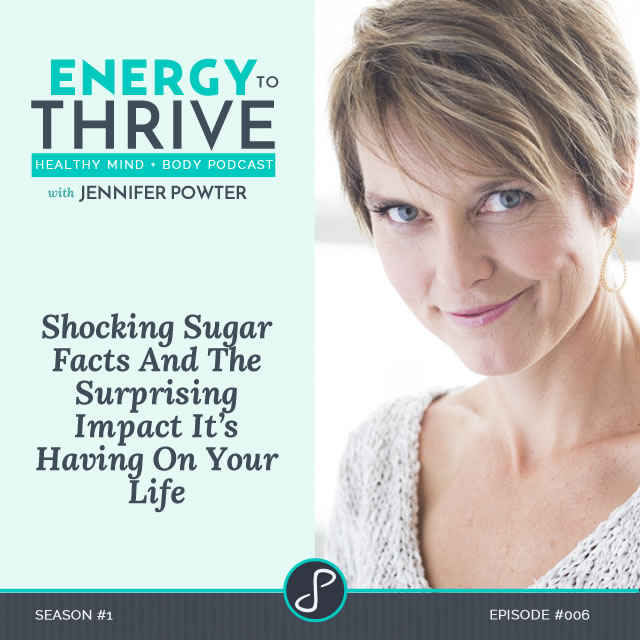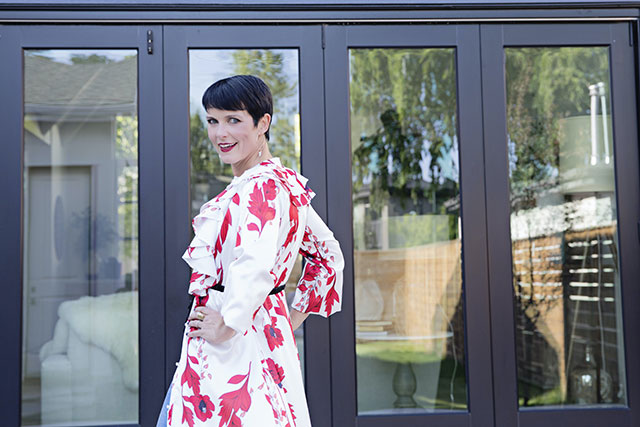Podcast: Play in new window | Download
It’s been said that sugar is the worst legalized drug of all, that it acts like cocaine or heroin in the brain and that it’s more addictive than both of those drugs.
North Americans are consuming sugar like never before – in fact, on average, ~160 lbs of sugar per year are consumed by the average person. That means eating about ½ cup to 1 cup of sugar a day. Shocking, right? You might think that you’re not doing this but you’ll be surprised how easy it is to do. Twizzlers anyone?
If you’ve been wanting to lose weight but feel like you’re sugar cravings hold you back, or if you suffer from a lack of energy or are worried about how much sugar your kids are eating this episode is for you.
*****Attention: I believe every mom should listen to this episode about sugar*****
In this episode you will:
- Learn the recommended amount of added sugar you can have in a day (as well as your kids) and how to stay within that limit
- Understand the tricky way that food companies started the war on fat and how the effect of the non-fat, low-fat movement has contributed to our obesity crisis
- Realize the impact of normal, everyday things on your child’s health (think popsicles, ice cream, orange juice, candy), and your own
- Finally get the role sugar plays in the prevention of your weight loss efforts
- Hear the best word you should start saying to yourself and your kids. It’s one syllable – can you guess it?
- [Tweet ““Dessert shouldn’t be an everyday occurrence.””]
Episode Resources:
- Salt, Sugar, Fat – How the Food Giants Hooked Us by Michael Moss
- 10 Step Sugar Detox Pdf – www.jenniferpowter.com/sugar-detox
- 28-Day Sugar Fix Program – www.jenniferpowter.com/sugar-fix
- Interesting blog post on sugar
- Also, here is a handy conversion chart so you can truly understand how much sugar is in something. For me, hearing there’s “X” amount of grams used to mean nothing but understanding how many teaspoons, tablespoons, or cups was far more impactful. Download it here: Handy Conversion Chart
Shocking Sugar Facts And The Surprising Impact It’s Having On Your Life [Full Text]
Jen: Thanks for tuning in. This episode, called Shocking Sugar Facts and the Surprising Impact It’s Having on Your life, is a topic that is near and dear to my heart. I think it is so important that we get a handle on what sugar is, where you can find it, how it’s added, what we do or how it affects us when we eat it. This is true for anybody who is trying to lose weight, anybody who wants to have more energy, anybody who is a mom out there and you feel like your kids are crazy addicted to sugar or they can’t get enough.
I’m going to go through a bunch of stuff here. The first being explaining how much sugar are we supposed to be eating in a day and what’s actually happening in North America, giving you some examples of common high sugar products and some suggestions, and really explaining how this all came to be, how in this day and age this is such a problem when we have such incredible education and movements to try to help the whole population get healthy.
Here’s the deal. If you’re a woman, your average recommended daily added sugar intake should be no more than 24 grams of sugar. Now, 24 grams is the equivalent of six teaspoons. The math on that is one teaspoon of sugar has 4 grams in it.
This is a really important thing to get. Just remember that the average intake for you should be no more than 6 added teaspoons. This means besides the sugar found in fruits and vegetables, those natural occurring sugars. I’m talking about all of those added sugars by food companies and also when you’re adding sugar to things like your coffee or your tea, or your cereal, things like that.
If you have children, children who are under 8-years-old the average recommendation for them is to have three to four teaspoons, or 12 – 16 grams of sugar per day. For teenagers, they’re a little bit more active, so they’re about five to eight teaspoons of sugar, or 20 – 32 grams.
This will all make sense more in a moment when I explain what common foods, literally by taking half a bottle and drinking it you’re at your sugar intake. Let’s go back a bit and take a look at some pretty startling stats.
Right now we have the biggest crisis of disease on our hands. Child obesity has increased significantly among children aged 2 to 5. Type II Diabetes has increased by 30%. Did you know that one-quarter of teenage boys now have pre-diabetes? Teenagers. That’s crazy. Things like insulin resistance, diabetes, heart disease, cancer, obesity, chronic fatigue, these are all things that are directly 100% related to sugar intake. The problem is that a lot of us are walking around with some of these problems and we don’t even understand that we are making them worse by our food choices.
Here’s what is crazy. The average North American is consuming about 150 to 170 pounds of sugar per year. That’s one person. That one person could be you. You might be thinking, “I don’t eat that much,” but I’m going to share with you how you might be.
150 to 170 pounds, that is the equivalent of one-quarter to a half pound of sugar a day. To give you the visualization of that, that’s about half a cup to one cup a day. It seems crazy, but it happens and it can add up really easily.
The scary thing is that for our children it’s even worse; they’re consuming seven times the recommended amount of sugar in a day. Then we wonder why our kids are having such behavior issues, attention problems, and seem so wired. We have to start peeling things back and looking at how we’re nourishing them.
What happens is for us, if you’re the parent, you are making the food choices. You’re the one who is going into the grocery store and you’re putting things into your cart and bringing them home. Your kids aren’t doing that.
Then what happens is when you’ve made that commitment to purchasing those items and they’re at home, if you’re like me sometimes you’re tired and kids are really good at being persistent, and sometimes you just get tired of saying no and you just want them to be quiet and go away to give you a break, and so you’re like, “Sure.” Kids are eating things like granola bars, fruit gummies, Fruit-by-the-Foot, flavored yogurt, just so much stuff that is not doing good things for them or for you.
What happened? How is it that we have so much sugar in foods nowadays? Where did that happen? The interesting thing is back in the 1800s the average person ate about 10 pounds of sugar in a year. Sugar was not a common thing. Dessert was not an everyday occurrence. Whereas now you can go to Safeway or whatever your supermarket is and get a pie, a box of cookies, some doughnuts or a cake, and come home. You could eat them all in one night if you wanted.
Most of us don’t do that, but I know a lot of families where dessert is an everyday occurrence. The problem with that is most of us have no concept of portion. Portions have ballooned over the last 30 years. What we now have as a small in a movie theater for a drink, for instance, would have been an extra-large in the ‘70s. We’ve become very disillusioned in terms of what is okay, how much, things like that.
Let me just share a little bit about what actually happened, because I really found this fascinating. How is it that our food products have just become so sweet? It goes back to the post-war era when more women were leaving home to go to work. In the ‘60s food companies were working like crazy to create convenience foods, comfort foods.
Think of TV dinners or powdered mashed potatoes that you would just add water to. The food industry was revolutionized by this. It kind of became a free-for-all where food wasn’t monitored very well, what was put into food wasn’t monitored very well.
There was a really critical turning point in 1999. This is a famous meeting that really no one knows about and it’s really how the sugar industry has exerted such influence on our health over the last few decades. I find this fascinating. Eleven CEOs, all men, met at the Pillsbury headquarters in Minneapolis. I’m talking about CEOs from Nestle, Kraft, Nabisco, General Mills, Proctor & Gamble, Coca-Cola, Mars. Together these companies earned $280billion in annual sales from convenience foods.
Now, what we have to take a look at is the facts that they were dealing with back then. Between 1980 and 1999 child obesity had doubled. Half of North America’s population was already considered to be overweight and almost one-quarter of the population, over 40,000,000 adults, were classified as clinically obese. Everything was on the rise; disease morbidity and mortality, diabetes, heart disease, hypertension, some cancers. Everything had skyrocketed.
What’s interesting is food had very much become an industrial product. One man, Michael Mudd, the VP of Kraft, did this presentation to his colleagues and he suggested that the food industry was part of the problem and so maybe they should actually become part of the solution. Maybe they should be changing how much sugar is added to products or funding some physical activity initiatives, or doing something to combat the health crisis that was clearly developing – had developed.
He finishes his presentation and the room was really quiet, no one said a word. Then the CEO from General Mills, Stephen Sanger, stood up and basically the gist of what he said was, “Forget it. It’s up to the consumer.” It’s up to people like you and me basically was what he was saying, it’s up to the consumer. “People buy what they like and we are not backing down.” He killed the initiative. No one had the guts to follow through on chasing this proposal, and so things got worse.
What’s also really interesting is back in the ‘70s they were kind of figuring out and there was some emerging research showing that sugar was directly related to a lot of things. What these companies did is basically the companies who used a ton of sugar are the ones who created the war on fat.
Do you remember it? If it was no fat, low fat it was good. Cheese was evil. Eggs were evil. Sour cream, cream cheese, whipped cream. Fat became the evil and sugar became okay. I remember munching on Twizzlers thinking, “It’s fat-free, so it must be good for me.” The marketing of food products with sugar to children at that time went ballistic, because of course nothing was monitored, cereals and things like that.
We are now at a point where if we don’t understand how much sugar is in stuff then we remain ignorant. We can’t afford to do that. You cannot afford to do that if you want to be healthy and if you want to pave the way for a healthy culture in your family.
Let’s take a look at some stuff here. You can’t see it, but I did a sugar presentation for a company earlier in the year, so I pulled a bunch of different things together. I want to share with you some things that you might not know.
Common product; Gatorade. You see it at every gas station, it’s in every store. A lot of parents buy Gatorade and keep it on hand for their kids to drink, especially if they’re playing sports. A bottle of Gatorade has 42 grams of sugar. Just under a quarter-cup of sugar in one bottle of Gatorade. That’s about 12 teaspoons.
If you’re taking a look at kids, that’s way more than what the average kid should be having. The thing is I’ve seen children under 8 drinking full bottles of Gatorade. We think, “I would never give my kid Red Bull or a Monster drink,” but we’ll give them a Gatorade.
What about just the common thing that is probably served at breakfast around the world, juice? Orange juice. I have a 340 milliliter container of orange juice right here and there is 39 grams of sugar in it. It’s exactly the same sugar as a can of Coke. Is orange juice really that much more healthy than Coke?
It does have some vitamins. If you have scurvy or a massive vitamin deficiency, then orange juice may be an okay choice. But, if you’re giving your kid a cup and a half of orange juice every day, that alone 34 grams is nine teaspoons, you’re giving them three times the amount of sugar they should be having in a day with one drink.
Do you want to know something interesting? What really turned a huge profit for food companies was the invention of Yoplait. Do you remember that? It was that runny sugary sweet stuff and they marketed it as a breakfast food. I know women around the world went crazy for Yoplait. You really might as well have eaten a chocolate bar.
That’s the same for if you’re eating any kind of flavored yogurt right now. I have a container of Lucerne low fat fruit on the bottom French vanilla yogurt right here, it’s one of the containers that has the little tin foil top that you peel back. No word of lie, the amount of sugar in here is 21 grams of added sugar. A Kit-Kat chocolate bar has 22 grams of sugar in it.
Seriously, if we’re trying to think about our health here, we have to look at the bigger picture. We have to start feeling informed and understand what our food choices actually mean. This is especially true if you have children.
I am going to talk about this a bit, because I have two children and they are insane for sugar sometimes and they have not grown up with a lot of it. My son seems to have a preference for it more than my daughter, but both of them can handle some pretty sweet stuff.
It was in Michael Moss’s book, Sugar Fat Salt, that I understood a term called bliss point. The bliss point is the maximum amount of flavor – sugar and salt – that can be put into a product where the person can’t stop eating it. If it’s too sweet, we’ll put it away, “Oh, that’s too sweet for me.” It’s that maximum amount that we can handle where it’s satisfying and almost addictive.
What’s fascinating is children have a bliss point that is twice as high as an adult’s. That’s why they can maw down on things like cotton candy or toxic waste or whatever some of those popular candies are when you go into a candy store.
Here’s the thing. Why we have to understand portion is because everything is getting bigger. I was at the airport, because I travel a fair bit, and I was in the little kiosk getting some water. I was hungry, so I was looking at what was around. All they had were these bags of candies. I wasn’t really looking at these for me, I was just curious to see what they had and what people were buying.
Remember when they used to make little bags of Skittles that were tiny? There were no tiny bags of stuff available anywhere. It was medium sized bags and they were 150 gram bags. I saw lots of kids walking around with them. There were sour watermelon slices, fuzzy peaches, the Swedish raspberries, that sort of stuff. Lots of people were eating this stuff.
I took a look at it and I picked it up. It says on the back that the serving size was six pieces. Now, most people don’t know how to actually read a label properly. If you do the math on that, six pieces equals 40 grams, this is a 150 gram bag, so there are basically four servings per bag. Per serving there is 22 grams of sugar.
If you eat the whole bag, which I’m putting my hand up here because I’ve done that, I would have just consumed 88 grams of sugar, which is just over seven tablespoons. Eight tablespoons is half a cup. At one time, in one sitting. There were lots of kids just eating out of the bag of candy and about to go on a plane late at night.
We have to start paying attention. You’re thinking, “I eat pretty healthy.” You might. But let’s say you have half a cup of your French vanilla yogurt, nonfat or low fat yogurt, for breakfast. Maybe you have a cup and a half of orange juice. You need a little snack later in the day, so you grab a chocolate bar from the vending machine.
Right there, that’s half a cup. Then maybe you play sports or you train or you workout, and you’ve heard it’s good to drink Gatorade, and so you have that. Now you’re almost at three-quarters of a cup. You can see how it starts to come in really easily.
What happens with sugar is there is some pretty big ramifications. What I want you to get is if you have kids the best word you need to learn is no. No. Not today. Not right now. Not tonight. Maybe on the weekend. It is the word no. And maybe you need to learn it for yourself, too. No. I choose my health over sugar. No, not today. No, not that much.
The way that I’m able to live so freely with food in my life is I have the rule that I can eat whatever I want, but I keep the portion in check. There is a really great ice cream store that opened up not too far from my house and I don’t live this puritanical ultra clean green lifestyle, I still enjoy taking my kids to get ice cream. They have birthday cake. We’re a no pop household and a no juice household, but we do have lots of treats in different ways.
I joke that there is a reason there’s a size small and a kid’s cone, because that is the portion a child should have. It’s the portion size I get when we go for ice cream, which is how I’m able to enjoy it. I don’t need two scoops. I do not need two cups of ice cream to come into my body, it’s just too much.
Here’s the impact of having a lot of sugar in your life, especially for women.
It crushes your confidence. When you eat sugar all the time and you feel like you can’t stop, there is an incredible hormonal and emotional cycle that gets put in play. Sugar consumption is very much related to emotional eating. When you’re sad, mad, tired, or bored, if you’re like me I don’t crave kale.
I don’t crave kale when I’m in any one of those emotional states. I crave comfort, I crave nourishment, I crave something to just let me have some relief in the moment, “I’m a good person. I just want to feel happy.” In that moment, chocolate might make me happy. It might make you happy, too.
The problem is that food never fixes a feeling. The sugar doesn’t do anything. For that brief moment you eat it and then this hormonal chemical reaction happens in your brain and your brain likes it, “I like that. Now I feel good,” and so it makes you want more.
When you try to cut out sugar from your life and you don’t have other strategies in place to help you, it makes it really difficult to break the habit, especially with dieting. Obviously I work with women who have been on chronic diets, don’t feel like they can ever be successful, and get so frustrated and down on themselves. Sugar and the food choices are a huge part of it.
The thing that we need to understand is a lot of women are still afraid of fat. They still believe that fat makes them fat, so they have been conditioned to the no fat, low fat craze of the ‘80s and ‘90s and haven’t moved out of it. Fat doesn’t make you fat. Overeating will make you fat. Consuming too much sugar definitely will as well.
The problem is that when we mindless munch on a bag of candy or something, if you like exercise and are trying to use exercise as a weight loss method, no woman in the world has enough time to out-train her nutrition. We have to make sure that things are in check and in balance.
Start paying attention. Start looking at labels. How much sugar is coming into your diet every day? Where can you limit? The obvious ones are your liquid calories.
I have a Starbucks in my neighborhood, I like their Frappuccinos. Did you know that there is a quarter cup of sugar in it? That’s a lot. That’s about 12 teaspoons; double what we’re supposed to have. That’s just through one drink. When you start to cut back on sweetened yogurt, juice, pop, all of the crazy coffee drinks, you will start to see a difference. Then you can work on the food stuff.
What happens in your body is when you start to consume too much sugar over time it can lead to something called insulin resistance. Insulin resistance can then lead to diabetes, I think that we understand that.
What happens is your body likes to live in homeostasis, that’s what it enjoys. When you eat something and there’s a ton of sugar in it, your body likes to get rid of it, it doesn’t like to have high blood sugar. Insulin gets released, that’s a hormone, and it tries to push all of that sugar out of your bloodstream and it tries to get it to the places that it can go. It tries to push it into your muscles, where it can get stored. It will try to push it wherever it can get stored. If there’s no other storage places, guess where it goes? It goes into your fat cells and it gets stored there. Yes, there is a conversion process, but that’s the simplified way of explaining it.
Then we’re just waiting to use it. But if you’re constantly eating and consuming sugar, you never get a chance to use the stored stuff that’s in your body because you’re eating new stuff all the time. That’s how weight gain can start to happen.
Obviously I’m pretty nerdy about this, but what’s interesting and what some people don’t understand is that sugar is the simplified version of carbohydrate. In fact, my partner didn’t understand this and he’s a smart guy. He said, “Wait. Carbohydrates, so rice, pasta, bread, all of that just breaks down in your body, that’s all sugar?” Yes. They’re chemical compounds that are linked together in different ways, but yes, that’s what it breaks down to.
So it doesn’t even have to be that you’re eating this kind of stuff, it could just be that maybe you have a ton of pasta in your life, or you’re eating rice every day, white rice, white pasta, white bread, that sort of thing.
What I want to inspire you or get you thinking about is if you choose to change the relationship you have with sugar you will be changing your health for the better and truly creating a healthier environment for you and your family to live in.
The ways that you have to do that are:
1) You have to remember that you are living in a sugar economy and you are the dealer. The grocery store is the supplier and then you deal it to yourself and you deal it to your kids. Start by really checking in with yourself when you’re grocery shopping and ask, “Do I really want to make the commitment to let myself and my kids eat this?” Check the labels, see how much added sugar is in there.
2) Start to really think about the other foods that are important for you, like vegetables, like good quality protein, and like water.
If you want to try to conquer some of your sugar cravings the best thing you can do is start to pay attention to things like are you getting good sleep, do you have a proactive way to manage your stress, are you hydrated during the day (and not just with coffee or pop), do you have support, are you able to talk and share things with a friend or your partner when life feels hard.
Start asking yourself when you think you crave something, “What is it I really need right now?” The answer will almost never be sugar. You might trick yourself, the mind is tricky, and you might feel like that’s the thing that you want, which is why the pause is so important. Pause and check in and start to play the what if game. “What if I had a glass of water right now? What if I went and had a nice hot shower? What if I called a friend and connected? What if I took myself out for a walk?” You get the idea.
Start to create some boundaries in your family life, in your life. Start to take a look at after school. No, kids do not get crackers, chips, and granola bars; they get a fruit tray or a veggie tray. That’s the number one thing. I have it ready to go so that when my kids come in that’s what is there.
The funny thing is if you have it ready and on the counter, they’ll eat it. If you have the veggies on a counter along with crackers, chips, or granola bars, then they’ll eat that stuff. You have to make it the primary option. Do that for yourself as well.
I’m really conscious of our time here, because I know I could go on and on about this. My biggest request is if you want more information on this, please go to the blog page for this episode and leave your questions, leave your comments. Let me know what else I could do or talk about to share this with you. It is my goal to get a couple of really amazing authors onto the podcast and be able to probe their brains a little bit for practical tips.
I wish you a summer of health and energy and vitality. The number one way that you’re going to feel that and experience that is by cutting back on the sugar consumption, and doing that for kids too. Honestly, this isn’t about being perfect. It’s just about saying no a little bit more often than you are right now and explaining that I’m doing it for your health, “We can’t have that much sugar because sugar makes us sick, sugar is not good for the insides of our body,” and teaching your kids about that value.
That’s it for now. Thank you for tuning in. I can’t wait to hear your comments. You can find everything that I’ve talked about here on the show notes. I’ll see you in the next episode of Energy to Thrive. Bye for now.
I forgot one thing. If you are interested in wanting to learn how to give yourself a full day to cut back on sugar, you can grab my free 10 Step Sugar Detox PDF at JenniferPowter.com/sugar-detox. If you want to jump right in to understanding and diving into some of the physiology and how to set your environment up for success and really cut back on sugar in your life, you can get my 28 Day Sugar Fix Program at JenniferPowter.com/sugar-fix.
Bye for now.




